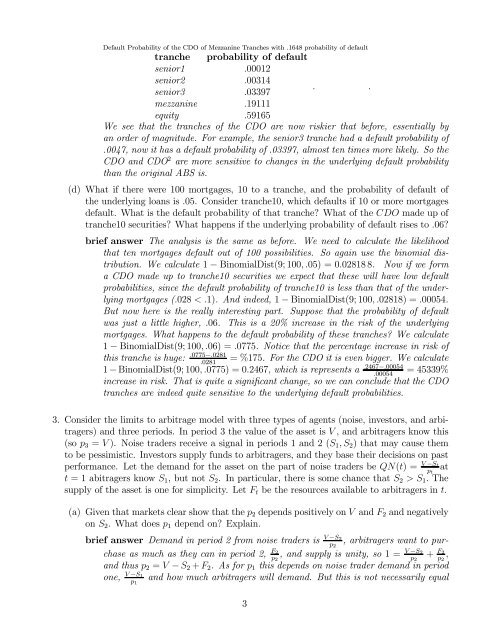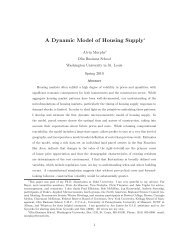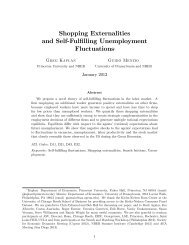Homework Assignment #1:Answer Key
Homework Assignment #1:Answer Key
Homework Assignment #1:Answer Key
Create successful ePaper yourself
Turn your PDF publications into a flip-book with our unique Google optimized e-Paper software.
Default Probability of the CDO of Mezzanine Tranches with .1648 probability of default<br />
tranche probability of default<br />
senior1<br />
00012<br />
senior2<br />
00314<br />
<br />
<br />
senior3<br />
03397<br />
mezzanine .19111<br />
equity<br />
59165<br />
We see that the tranches of the CDO are now riskier that before, essentially by<br />
an order of magnitude. For example, the senior3 tranche had a default probability of<br />
.0047, now it has a default probability of .03397, almost ten times more likely. So the<br />
CDO and CDO 2 are more sensitive to changes in the underlying default probability<br />
than the original ABS is.<br />
(d) What if there were 100 mortgages, 10 to a tranche, and the probability of default of<br />
the underlying loans is 05. Consider tranche10, which defaults if 10 or more mortgages<br />
default. What is the default probability of that tranche? What of the made up of<br />
tranche10 securities? What happens if the underlying probability of default rises to 06?<br />
brief answer The analysis is the same as before. We need to calculate the likelihood<br />
that ten mortgages default out of 100 possibilities. So again use the binomial distribution.<br />
We calculate 1 − BinomialDist(9; 10005) = 002818 8. Now if we form<br />
a CDO made up to tranche10 securities we expect that these will have low default<br />
probabilities, since the default probability of tranche10 is less than that of the underlying<br />
mortgages (028 1). Andindeed,1 − BinomialDist(9; 10002818) = 00054.<br />
But now here is the really interesting part. Suppose that the probability of default<br />
was just a little higher, 06. This is a 20% increase in the risk of the underlying<br />
mortgages. What happens to the default probability of these tranches? We calculate<br />
1 − BinomialDist(9; 10006) = 0775. Notice that the percentage increase in risk of<br />
this tranche is huge: 0775−0281 =%175. For the CDO it is even bigger. We calculate<br />
0281<br />
1 − BinomialDist(9; 1000775) = 02467 which is represents a 2467−00054 = 45339%<br />
00054<br />
increase in risk. That is quite a significant change, so we can conclude that the CDO<br />
tranches are indeed quite sensitive to the underlying default probabilities.<br />
3. Consider the limits to arbitrage model with three types of agents (noise, investors, and arbitragers)<br />
and three periods. In period 3 the value of the asset is , and arbitragers know this<br />
(so 3 = ). Noise traders receive a signal in periods 1 and 2 ( 1 2 ) that may cause them<br />
to be pessimistic. Investors supply funds to arbitragers, and they base their decisions on past<br />
performance. Let the demand for the asset on the part of noise traders be () = − <br />
<br />
at<br />
= 1 abitragers know 1 ,butnot 2 . In particular, there is some chance that 2 1 The<br />
supply of the asset is one for simplicity. Let be the resources available to arbitragers in .<br />
(a) Given that markets clear show that the 2 depends positively on and 2 and negatively<br />
on 2 .Whatdoes 1 depend on? Explain.<br />
brief answer Demand in period 2 from noise traders is − 2<br />
2<br />
, arbitragers want to purchase<br />
as much as they can in period 2, 2<br />
2<br />
, and supply is unity, so 1= − 2<br />
2<br />
+ 2<br />
2<br />
<br />
and thus 2 = − 2 + 2 .Asfor 1 this depends on noise trader demand in period<br />
one, − 1<br />
1<br />
and how much arbitragers will demand. But this is not necessarily equal<br />
3

















